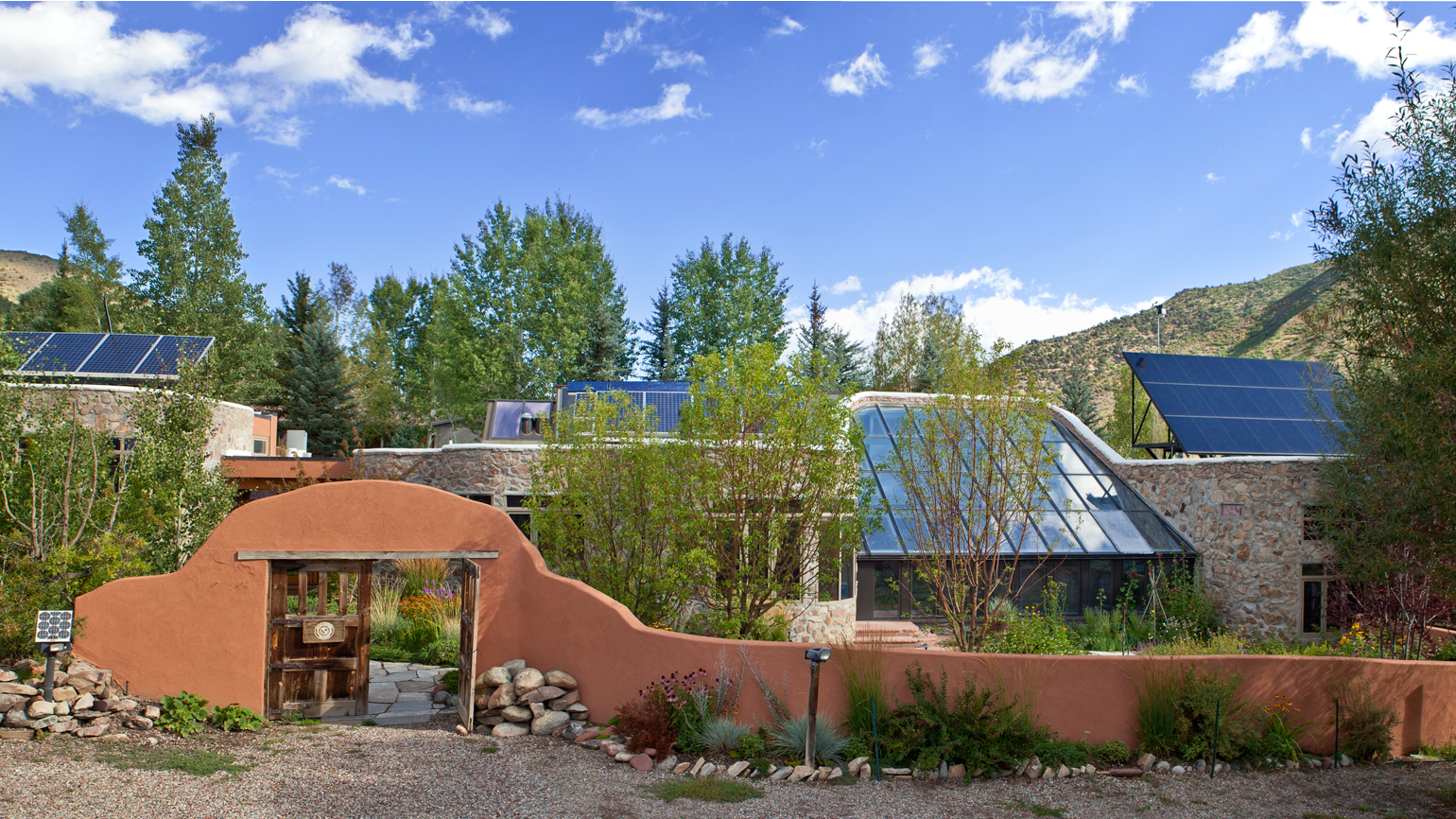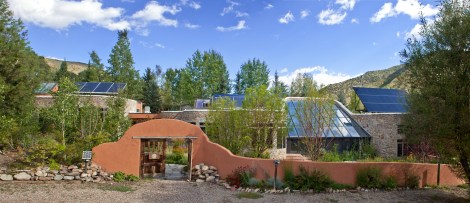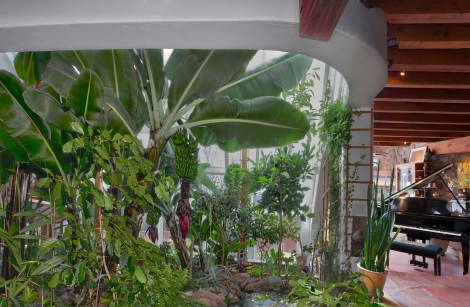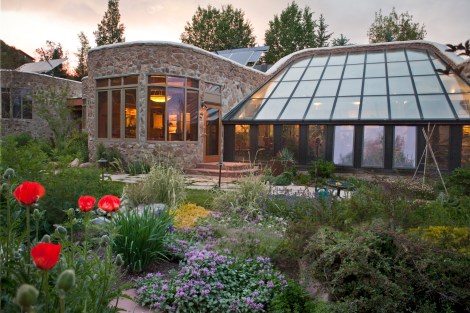For most of its history, environmentalism has been associated with a back-to-the-land lifestyle: being one with nature, living in the woods, wearing sandals, maybe driving a Volkswagen. Over the last decade, a counter-narrative has taken over. Cities are in. As climate change has become the dominant environmental issue, a low-carbon lifestyle has become the priority. Denser living is heralded for its energy efficiency, as are walking, biking and taking transit instead of driving.
All other things being equal, walkable urbanism beats sprawl. But one house in Old Snowmass, Colo., demonstrates that, with the right design, rural living can be about as low-carbon as possible. And it turns out those hippies were on to something: the secrets to low-impact rural housing lie in embracing nature instead of combatting it. Plus it helps to have some bleeding-edge technology.
Amory Lovins, the owner of the house, is exactly the guy you’d expect to live here. A bespectacled physicist and world-renowned energy-efficiency expert, he cofounded the Rocky Mountain Institute in 1982 with his then-wife L. Hunter Lovins. They chose this location, nestled up in the mountains 14 miles from Aspen, for RMI’s first headquarters, which they built as a model of energy efficiency. The original structure was completed in 1984. Today, RMI has expanded into other buildings, but Lovins still lives in the original house, which got a high-tech makeover in 2009.

© Judy Hill LovinsAmory Lovins with his bananas.
Lovins instructs visitors to drink water, because the house’s high elevation, around 8,000 feet, causes dehydration, and he throws on a goofy fisherman’s hat to protect his bald head when going outside. He calls his home “the Banana Farm,” after the tropical fruits grown in its greenhouse.
Many suburbanites have rejected the housing styles best suited to their specific environments, instead embracing a generic image of the American Dream that is often regionally inappropriate. Picture green lawns baking in the Arizona desert. The Banana Farm, however, adopts the classic adobe style indigenous to the Mountain West.
The primary challenge to building a super-efficient home in the mountains is heating. It can get very cold on winter nights in Old Snowmass, as low as -30 Fahrenheit. Heating a home here is an energy-intensive, and expensive, proposition. And so Lovins’ single biggest insight was to design it with walls so thick that it didn’t require heating.
In an arid mountainous area, the sun is strong during the day. So the 16-inch thick walls — made of concrete, locally harvested sandstone, and a middle four inches of polyurethane — are adept at storing heat throughout the day and retaining it overnight. Typically, an architect would recommend increasing the wall thickness until the point where the marginal savings on heating are passed by the increased costs of building. But Lovins went twice as thick, thereby eliminating the need to build a heating system at all. “We saved $1,100, and that’s just on the building, never mind operating the heating,” Lovins boasts.
Windows are a major source of air leakage, so the building has “super-windows,” which have microscopically thin layers of gases such as krypton and xenon that let in light but prevent heat exchange. “It’s equal to 16 layers of glass but it uses only two layers and costs less than three,” says Lovins.
Keeping rooms warm is not the only purpose for which most houses require oil or natural gas. To make a “combustion-free” house, Lovins had to solve a few other problems such as drying clothes and heating water. The answer is to harness the sun’s natural heating power. Although they have a dryer, Lovins and his current wife Judy usually hang their clothes on a line that can be raised by pulley up into a skylight and dried in the sunlight. They heat water through eight thermal solar panels and send it around the house through pipes that are extra wide and turn at gentle angles to minimize the electricity needed to move it.
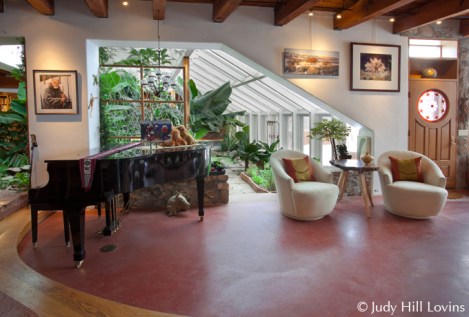
The house’s electricity is all renewable. Massive solar panels adorn the roof, carport, and grounds alongside the building. The panels produce far more solar power during the day than the Lovinses use, so they sell electricity to the grid during the day and buy wind energy from the grid at night. They also store the solar power in batteries so that they could be fully self-sufficient in a blackout. The batteries would run down at night but be recharged during the day. “In February 2013, there were five power failures [in the area], and we never lost power,” says Lovins.
Super-efficient appliances are another reason that the house uses less than half the electricity of most comparable-sized homes. The dishwasher, from Swedish company Asko, has sensors that measure the cleanliness of the water coming out and stop washing when the water is clean, instead of continuing to run for another hour. The result is that it uses two-thirds of the water and electricity of a typical dishwasher. The fridge and freezer are also designed to save more energy than typical models. The compressor, which gives off heat, is located at the top rather than the bottom, so that as the heat rises it goes away and does not necessitate more cooling. The electric stove comes with specially designed copper pots that retain heat and can boil water at an incredible speed. The lights are all LED, and track lighting helps distribute light more efficiently around the large living room.
The main trick, though, is not using more advanced technology, but using the oldest one available. In the middle of the building, between the living area and the office, is a greenhouse. A wide section of roof over it is glass, allowing sunlight and heat to pour in, helping to reduce the need for lighting. “You basically don’t turn the lights on during the daytime,” says Lovins. The building’s rounded walls distribute the light more effectively than a typical house full of right angles.
Lovins grows tropical fruit in the greenhouse, not just the eponymous bananas but mangos and even coffee. The plants consume CO2 and release humidity. They also store heat. The greenhouse also features a pond, which adds ambient noise, a nice feature because such a tightly constructed and mechanical-free house might otherwise be eerily quiet.
Even the bathroom contains oddball innovations, such as a sink on top of the toilet tank, so that when you flush the toilet you can wash your hands in the water that will then refill the tank. (This apparently is common in Japan because space there is at such a premium and it saves the need for a separate sink.)
Lovins drives an electric car and charges it with solar power. Of course, he’d be an even greater net clean energy contributor if he didn’t need a car at all, much less his second one for long trips that exceed the electric car’s range. But the Lovinses manage to live a lifestyle that is remarkably low-impact without being abstemious. They even have a solar-heated hot tub.
Looking out at the stunning mountain views they enjoy from the hot tub, it’s understandable why they wouldn’t want to trade in their 4,000-square-foot house for a cramped urban apartment. And thanks to smart design, they don’t have to.

